- Products
- ProspectSQL/MQL list building with high levels of personalization, real-time data enrichment and prospect search
- Email FinderFind individual or bulk emails by entering the person & company name or domain
- Email VerifierVerify emails addresses individually, in bulk or through API, with 99% accuracy
- Clearout For SheetsVerify email addresses directly on Google Sheets with Clearout for sheets add-on
- ClearoutPhoneValidate phone numbers across 240+ countries in bulk, quick or real time validation Free Tools
- Disposable Email Checker
- Reverse LinkedIn Profile Lookup Tool
- Reverse Email Lookup Tool
- Email List Cleaner
- Resource
- Pricing
- Integrations
- Enterprise
- Login
12 Best Practices for Lead Nurturing Emails
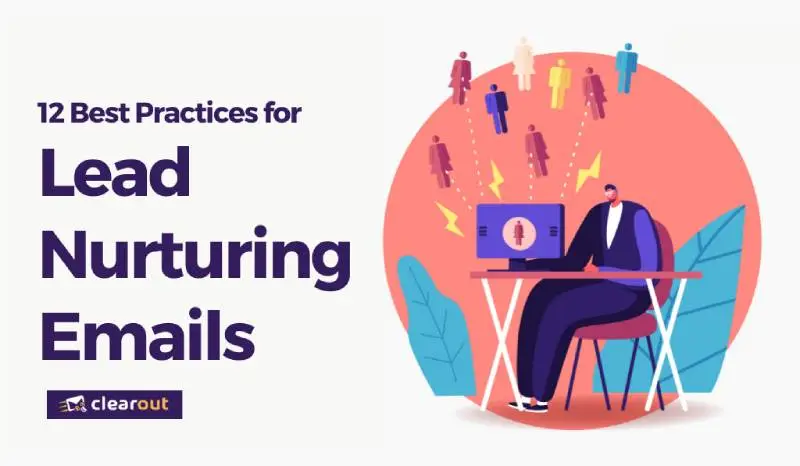
Lead nurturing emails entitle you to cultivate connections with your prospects and draw them into the sales funnel. It is one of the most suggested and successful methods of email marketing.
It allows you to interact with prospects and maintain meaningful contact. That means your brand will be at the front of the prospect's mind when making their next purchase.
According to email marketing experts, this lead nurturing email works so well in capturing consumers because it operates on a different concept. It first gets them thirsty before showing them where the glass is.
Simply said, it significantly enhances the likelihood of your leads making a purchase.
Now comes the question of how to get started. You can't just search up some examples, copy them, and start sending emails to your leads. Before writing an effective email, you should first understand how lead nurturing emails function from the inside out.
So, Let's Get Started!
It allows you to interact with prospects and maintain meaningful contact. That means your brand will be at the front of the prospect's mind when making their next purchase.
According to email marketing experts, this lead nurturing email works so well in capturing consumers because it operates on a different concept. It first gets them thirsty before showing them where the glass is.
Simply said, it significantly enhances the likelihood of your leads making a purchase.
Now comes the question of how to get started. You can't just search up some examples, copy them, and start sending emails to your leads. Before writing an effective email, you should first understand how lead nurturing emails function from the inside out.
So, Let's Get Started!
What is Lead Nurturing Email?
Lead nurturing emails are emails delivered to users to move them from the contemplation stage of the sales funnel to the decision stage. These emails are intended to provide additional information about a product or service and emphasize its most significant aspects.
Marketers use lead nurturing emails to persuade leads to buy their products. A smart lead nurturing email engages, allures, and inspires your lead to buy from your company.
In the lead nurturing emails, social proof and user-generated material are frequently utilized to appeal to the leads' emotions. They often offer substantial discounts to entice prospects to make a purchase.
Marketers use lead nurturing emails to persuade leads to buy their products. A smart lead nurturing email engages, allures, and inspires your lead to buy from your company.
In the lead nurturing emails, social proof and user-generated material are frequently utilized to appeal to the leads' emotions. They often offer substantial discounts to entice prospects to make a purchase.
Why are Lead Nurturing Emails Effective?
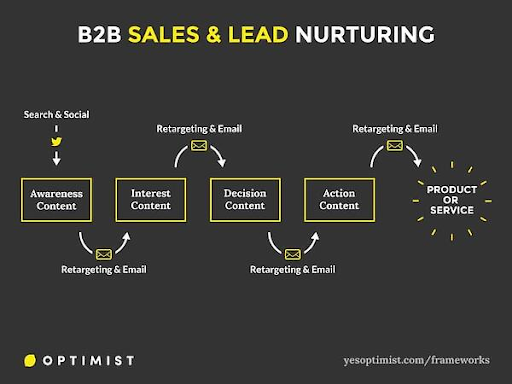
Marketers that use email marketing to nurture leads have a higher conversion rate. You can progressively nurture and prepare prospects to perceive your brand favorably through lead nurturing.
Social media may be used for marketing and lead nurturing, but the main disadvantage is too much competition and distraction. This drastically diminishes the likelihood that your audience will remember you.
On the other hand, lead nurturing emails are far more successful since they can be tailored, capture your leads' full attention, and provide a wider range of interaction options. Proactive customer support is crucial for lead nurturing emails as it shows the customer that you care about their experience and are willing to go the extra mile.
As a result, lead nurturing emails are vital to conversion success.
Let's get started with the best practices and tactics for making your lead nurturing emails perform brilliantly.
Social media may be used for marketing and lead nurturing, but the main disadvantage is too much competition and distraction. This drastically diminishes the likelihood that your audience will remember you.
On the other hand, lead nurturing emails are far more successful since they can be tailored, capture your leads' full attention, and provide a wider range of interaction options. Proactive customer support is crucial for lead nurturing emails as it shows the customer that you care about their experience and are willing to go the extra mile.
As a result, lead nurturing emails are vital to conversion success.
Let's get started with the best practices and tactics for making your lead nurturing emails perform brilliantly.
Best Practices for Lead Nurturing Emails
Employing lead nurturing emails to foster your connection with potential prospects may be quite powerful when done correctly. Here are 12 recommended practices and methods for creating exceptional lead nurturing emails for your brand:
1. Know Your Customer
Lead nurturing is a constant and meaningful communication process with your consumers, which is only feasible if you know them. Pay attention to your customers and create messaging that will assist them in connecting with your company.
It will take time to know your consumers and their preferences better. Put yourself in their position and attempt to find out the solutions to questions like:
"How would this product benefit my business?"
"Are there better options available?"
"Is it reasonably priced?"
The responses will enable you to give better solutions to their problems. And when your sales pitches are more accurate and relevant, customer service improves.
It will take time to know your consumers and their preferences better. Put yourself in their position and attempt to find out the solutions to questions like:
"How would this product benefit my business?"
"Are there better options available?"
"Is it reasonably priced?"
The responses will enable you to give better solutions to their problems. And when your sales pitches are more accurate and relevant, customer service improves.
2. Qualify your leads
Lead qualification is critical to identify potential buyers from hoarding other leads. It syncs with your understanding of a superior consumer. As a customer who is close to the ideal customer profile (a.k.a ICP) has elevated odds of transformation.
Let's have a look at the three crucial steps to lead qualification:
1. Verify your lead’s email address. Make sure you reach out to someone valid and not talk in thin air.
2. Defining lead qualifications for your workflow
3. Designing an ideal buyer persona
The lead qualification process lets you know if a lead is worth the time, energy, and capital you invest in them during numerous phases until they become your regular consumer.
Let's have a look at the three crucial steps to lead qualification:
1. Verify your lead’s email address. Make sure you reach out to someone valid and not talk in thin air.
2. Defining lead qualifications for your workflow
3. Designing an ideal buyer persona
The lead qualification process lets you know if a lead is worth the time, energy, and capital you invest in them during numerous phases until they become your regular consumer.
3. Segment Your Leads
Lead segmentation helps you give your leads a tailored, relevant, and meaningful experience. It enables you to nurture your audience by delivering the right content at the right time throughout the sales cycle.
Segmenting your leads makes your email nurturing job easy, but it also lets you segment leads as per their interests.
Marketers segment their leads in various ways, including buyer personas, smart forms, and site analytics. It's one of the reasons why landing pages are so crucial for your inbound marketing campaign, and so are the emails that lead to it.
Define key attributes that characterize your leads: sociographic, corporate, geographic, or psychographic. For example, let’s try dividing the customer base of an ice cream parlor based on its geographic location. An ice cream parlor segments a country based on different hot regions and focuses on the areas which are more inclined to buy ice cream.
Segmenting your leads makes your email nurturing job easy, but it also lets you segment leads as per their interests.
Marketers segment their leads in various ways, including buyer personas, smart forms, and site analytics. It's one of the reasons why landing pages are so crucial for your inbound marketing campaign, and so are the emails that lead to it.
Define key attributes that characterize your leads: sociographic, corporate, geographic, or psychographic. For example, let’s try dividing the customer base of an ice cream parlor based on its geographic location. An ice cream parlor segments a country based on different hot regions and focuses on the areas which are more inclined to buy ice cream.
4. Build a Powerful Landing Page
Landing pages are crucial in enabling possibilities to be seized and are extremely significant marketing possessions. Enterprises continually miss optimizing their landing pages, ignoring their significance in the lead facilitating funnel.
According to experts, a landing page is as important as a CV for a job application in marketing. So, ensure your landing pages are to-the-point, clear, and conversion-oriented. For example, this medical alert review features the top 5 highest-rated personal emergency response systems (PERS) for seniors they have tested. It includes the necessary information their target customer might consider before making a final decision (e.g. social proof, cost, and device compatibility).
Also, it follows the golden rule of good design: use as much white space as possible. Allow your text, photos, videos, and CTA buttons to stand out against a simple, distraction-free background. Consumers should be able to recognize key concepts quickly and be tempted to learn more, register, or download straight away. There are many landing page builders out there you can use to quickly and easily design high converting pages. Most comes loaded with templates and use drag and drop functionality for ease of use.
According to experts, a landing page is as important as a CV for a job application in marketing. So, ensure your landing pages are to-the-point, clear, and conversion-oriented. For example, this medical alert review features the top 5 highest-rated personal emergency response systems (PERS) for seniors they have tested. It includes the necessary information their target customer might consider before making a final decision (e.g. social proof, cost, and device compatibility).
Also, it follows the golden rule of good design: use as much white space as possible. Allow your text, photos, videos, and CTA buttons to stand out against a simple, distraction-free background. Consumers should be able to recognize key concepts quickly and be tempted to learn more, register, or download straight away. There are many landing page builders out there you can use to quickly and easily design high converting pages. Most comes loaded with templates and use drag and drop functionality for ease of use.
5. Provide Valuable Content With Expert Insights
In marketing, it is essential to add value in your content. Your priority should be to show your prospects how your product will ease their lives or why it is effective.
“Focus on creating valuable content and promoting it on the right channels, and your content becomes a lead magnet that braces your business,” says Rajat Chauhan of Techtic Solutions.
The best way to do this is by assuming your lead nurturing email is a short and crisp blog. For example, if you sell hardware tools, your nurturing email should focus on the "top ten considerations to make before purchasing any hardware tool."
Always remember you need to establish yourself as an expert. Anything related to your products should be clear to you before you start marketing and feeding the knowledge to others.
“Focus on creating valuable content and promoting it on the right channels, and your content becomes a lead magnet that braces your business,” says Rajat Chauhan of Techtic Solutions.
The best way to do this is by assuming your lead nurturing email is a short and crisp blog. For example, if you sell hardware tools, your nurturing email should focus on the "top ten considerations to make before purchasing any hardware tool."
Always remember you need to establish yourself as an expert. Anything related to your products should be clear to you before you start marketing and feeding the knowledge to others.
6. Write Tailored Content
Every customer is unique, and your content should be based on them and their behaviors. It is essential to consistently craft relevant and meaningful content for better results.
Here are a few tips you can keep in mind to write compelling content.
Here are a few tips you can keep in mind to write compelling content.
7. Focus on One Relevant Topic Per Email
Rather than discussing many topics in a single email, each should focus on a single subject and include a call to action (CTA). This will aid in preventing any confusion in your email, and your leads will be more inclined to take action if each email concentrates on one subject at a time.
For example, if your lead downloaded an eBook on gardening basics from a company’s website to help them learn about the topic, your first email’s topic could be “Tips and tricks for beginner gardeners.” That way, the company would be speaking directly to potential customers.
For example, if your lead downloaded an eBook on gardening basics from a company’s website to help them learn about the topic, your first email’s topic could be “Tips and tricks for beginner gardeners.” That way, the company would be speaking directly to potential customers.
8. Keep it Short And Catchy
The length of an email has a big influence on a lead. They should be able to glance at the email and know the value it provides to them within five seconds.
Information overload happens quickly in an email. Too much content or multiple CTAs can create confusion and push the leads away rather than engage them.
Usually, lead nurturing emails should be between 50 and 125 words long. It's fine to go longer to captivate your leads that are already showing some interest. But keep it concise whenever possible.
Information overload happens quickly in an email. Too much content or multiple CTAs can create confusion and push the leads away rather than engage them.
Usually, lead nurturing emails should be between 50 and 125 words long. It's fine to go longer to captivate your leads that are already showing some interest. But keep it concise whenever possible.
9. Ensure the Emails Progress Naturally
Setting a specific goal and designing the flow of your emails will create well-rounded campaigns to pull your leads through the sales funnel.
The first email after the initial conversion can be informative, while subsequent emails should continue to educate while allowing the lead to convert a second time. This is an excellent time to offer a free trial or a demo download.
However, don't be rash and put up a banner that says "Buy Now!" just to obtain a sale. To keep clients regular, progress on emails naturally.
Make sure you collect valuable subscriber data to help create campaigns that cater to their needs and interests. Determine what counts as a "sales-ready lead" with your sales team, and tailor your lead nurturing activities accordingly.
The first email after the initial conversion can be informative, while subsequent emails should continue to educate while allowing the lead to convert a second time. This is an excellent time to offer a free trial or a demo download.
However, don't be rash and put up a banner that says "Buy Now!" just to obtain a sale. To keep clients regular, progress on emails naturally.
Make sure you collect valuable subscriber data to help create campaigns that cater to their needs and interests. Determine what counts as a "sales-ready lead" with your sales team, and tailor your lead nurturing activities accordingly.
10. Automating Your Campaign
Automating lead nurturing procedures such as sending follow-up emails and forwarding appropriate materials based on the user's position in the buyer journey is known as automated lead nurturing. With automated lead nurturing, companies can reach out to potential prospects at the correct time with the right information.
Email automation could enable you to evaluate spur emails and establish what efforts you should make. That brings your expectations to perceive you’ve customized your message to your consumers.
There are two ways you can automate your nurturing email campaigns:
Email automation could enable you to evaluate spur emails and establish what efforts you should make. That brings your expectations to perceive you’ve customized your message to your consumers.
There are two ways you can automate your nurturing email campaigns:
11. Shape The Nurturing Trajectory (CTAs)
One of the main advantages of using emails for lead nurturing is that you can completely control how each prospect interacts with your business. Because of email automation, this otherwise tricky and time-consuming activity becomes simple.
Nurturing your leads involves personalizing your emails to the customer's journey. This includes sending emails that match and are consistent with your brand, logos, graphics, and colors. A nominee who acquires a PDF obtains a separate statement (saying “Thank you! Here’s how you can make the best of this PDF….”), and a nominee who couldn't get the PDF will obtain a separate memo (that would state “Check out this ebook to learn how Company X saves 12% in their energy costs…”).
Nurturing your leads involves personalizing your emails to the customer's journey. This includes sending emails that match and are consistent with your brand, logos, graphics, and colors. A nominee who acquires a PDF obtains a separate statement (saying “Thank you! Here’s how you can make the best of this PDF….”), and a nominee who couldn't get the PDF will obtain a separate memo (that would state “Check out this ebook to learn how Company X saves 12% in their energy costs…”).
12. Time Your Emails Properly
Email marketing's entire purpose is to convey the appropriate message to the right person at the right time. A lead nurturing campaign is the same way. It takes time, but if you do A/B testing, you'll be able to pinpoint the best send timings for your business.
SuperOffice says late afternoons have the highest open rates.
SuperOffice says late afternoons have the highest open rates.
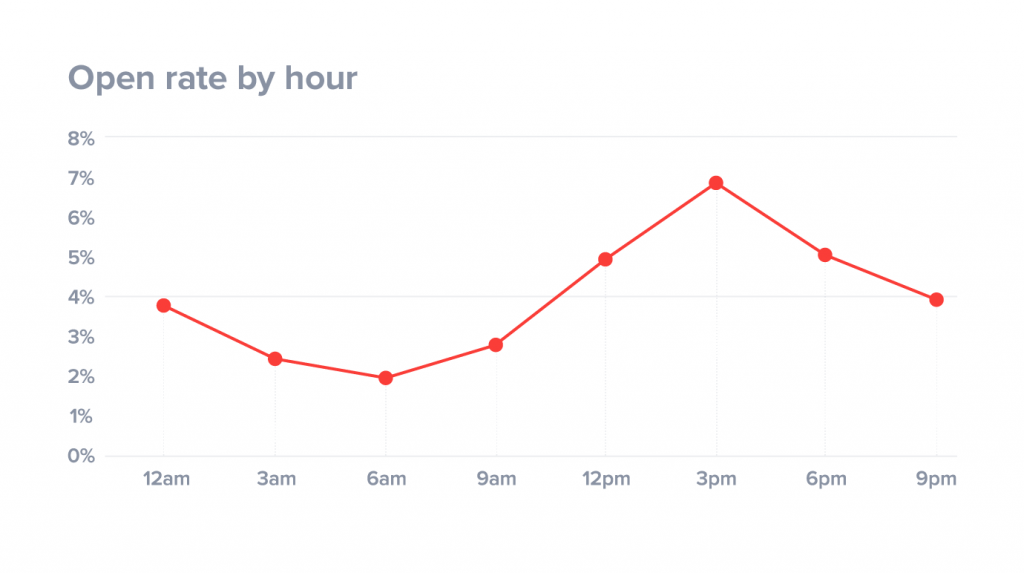
It doesn't make sense if a flawlessly constructed email were to attain your lead at the wrong time. It can be overlooked and concealed among hundreds of other emails in your recipient’s inbox.
Lead Nurturing Email Sequence
A lead nurturing email sequence is a series of emails automatically triggered when the lead takes a certain action.
Looks tough to get? This example may help you -
Once a customer adds an item to their cart (the action), a lead nurturing email sequence (triggered) could include a purchase reminder, a limited-time offer, or a list of similar products they may like. These sequences keep the lead engaged until they are ready to go forward with a purchase.
Looks tough to get? This example may help you -
Once a customer adds an item to their cart (the action), a lead nurturing email sequence (triggered) could include a purchase reminder, a limited-time offer, or a list of similar products they may like. These sequences keep the lead engaged until they are ready to go forward with a purchase.
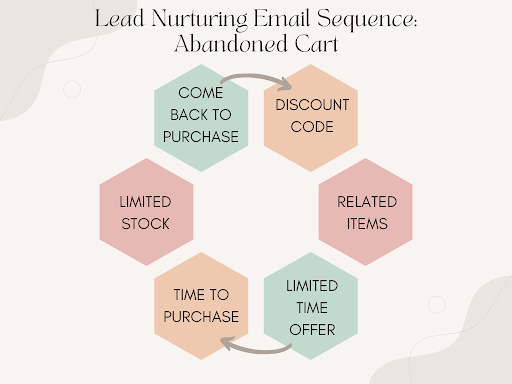
The process of lead nurturing requires time and continuous effort to gain your leads’ trust and understanding.
The different types of email sequences that can benefit your business:
1. Welcome email sequence - allows you to build trust and set the tone for pushing the sale.
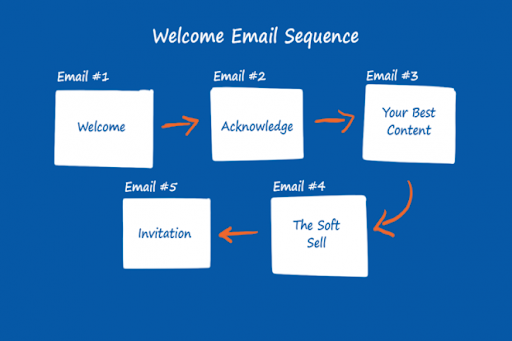
2. Confirmation email sequence - used to verify a subscriber's identity and to guide them through the onboarding process.

3. Onboarding email sequence - explains the benefits of your offer and how to use it, and can even include testimonials of satisfied customers.
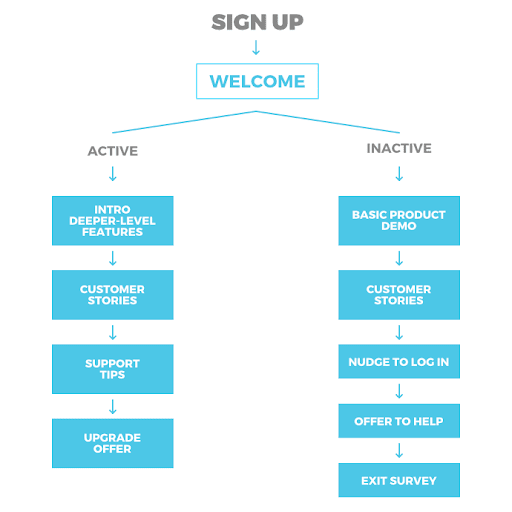
4. Cart abandonment email sequence - used to re-engage customers who have left a product in their shopping cart but never completed their purchase.
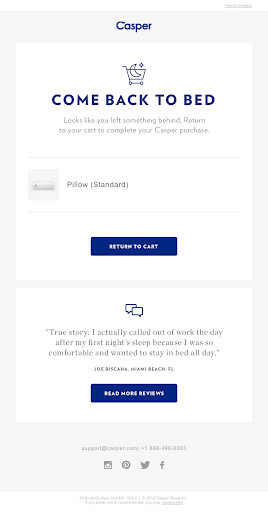
5. Repeat customer email sequence - used to upsell or offer similar recommendations to encourage the customer to make another purchase.
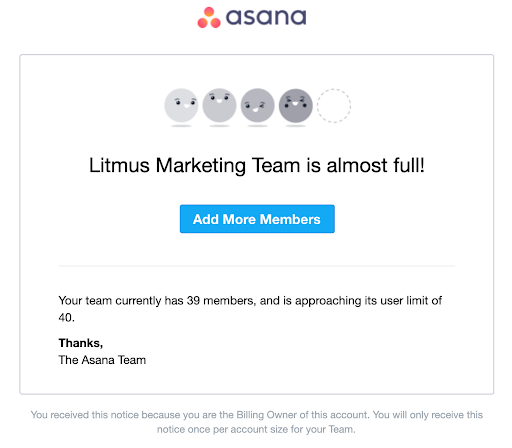
6. Re-engagement or reactivation email sequences - used to re-engage prospects who have stopped interacting with your company for an extended period.
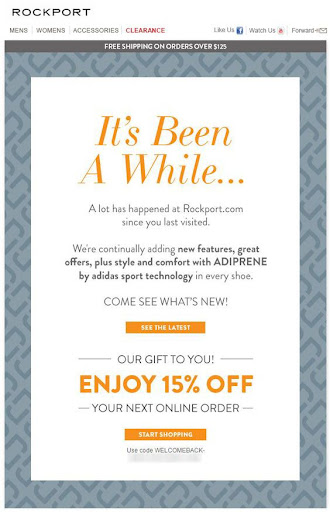
7. Event email sequences - used to remind users of upcoming events to encourage them to purchase tickets and make a reservation.
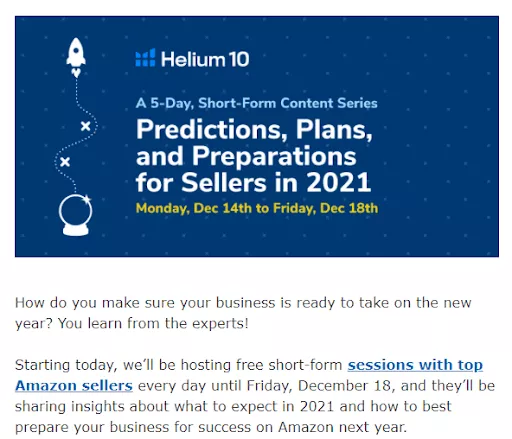
8. Follow-up email sequence - for reminding subscribers to complete tasks, such as making a purchase, reading a new blog post, completing an online course, responding to a survey, etc.
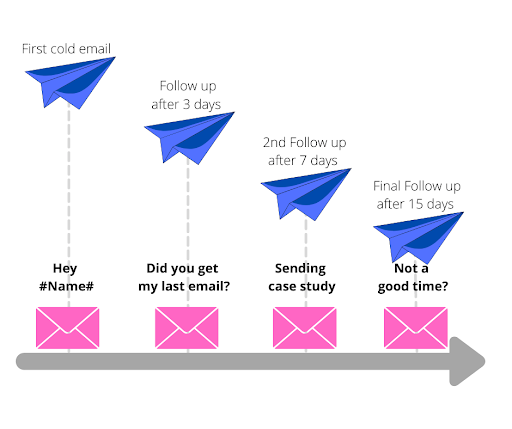
Nurture sequences are a simple yet powerful way to engage customers on a personal level and entice them to purchase your new product.
Industry Wise Lead Nurturing Email Examples to Get Inspired From
Here's a list of the best five examples of lead nurturing emails from different category brands to get inspired from:
eCommerce Lead Nurturing Email Example:
Your nurturing emails don't have to be over promotional. Sometimes, an engaging and attractive email is enough to entice your leads to open and read your email. Here’s how Framebridge does the same.

B2B Lead Nurturing Email Example:
Here's an example from Litmus that shows how a clear copy can provide recipients with an email that adds value to their experience.

Retail Lead Nurturing Email Example:
Uncommon Goods uses a very different method. They create a Pinterest-inspired section for each email to catch the receiver's eyes. They give a featured CTA for each collection that changes the sales email appearance to a curated pinboard.

Travel Company Lead Nurturing Email Example:
JetBlue, sends one of the best lead nurturing emails in the travel services market. Their emails are funny, helpful, and full of great puns elements to make them engaging and at the same time also reflect JetBlue's commitment to providing the best experience to their customers.

Services Lead Nurturing Email Example:
Freelancer never fails to catch attention. What they input in their emails, and more importantly, how they elaborate on the content, is truly appreciated.

Final Words…
Using emails for lead nurturing is undoubtedly one of the most cost-effective strategies to expand your sales pipelines. The entire lead nurturing process becomes more efficient and effective when the best lead nurturing practices and strategies are followed.
So, know your subscribers, listen to them, provide value, and create personalized lead nurturing email campaigns. And don’t forget to validate your leads’ email addresses before sending out emails to them to get the optimum campaign results.
So, know your subscribers, listen to them, provide value, and create personalized lead nurturing email campaigns. And don’t forget to validate your leads’ email addresses before sending out emails to them to get the optimum campaign results.
Build & Validate Your Email List With Clearout.io
Have a query? Reach out to us...
Recent Posts
01 Jul 2025
Best Zoho CRM Integrations for Sales & Marketing in 2025
Discover the top Zoho CRM integrations in 2025 categorized by use case. Explore how each tool's key ...
01 Jul 2025
Sales Automation in 2025: The Guide to Close More Deals Faster
Struggling with manual sales workflows? Follow this guide to explore the sales automation use cases, ...
25 Jun 2025
Top 6 Email Finder APIs in 2025 for All Use Cases
Looking for a reliable Email Finder API? Explore the top 6 email finder APIs of 2025—compare key fea ...
17 Jun 2025
Top 10 Email Spam Checker Tools Tested & Reviewed (2025)
Check out the top 10 email spam checker tools to avoid junk folders. Compare features, ratings & use ...
06 Jun 2025
How To Create a Lead Magnet That Converts in 2025
Looking for more leads? Read how to create a high-converting lead magnet in 2025 with step-by-step g ...
Prospecting ,Email Finder & Email Verification Service
Prospecting ,Email Finder & Email Verification Service
Expand your reach by discovering and verifying the ideal prospects.
Sign up & get 100 free credits | No Credit Card required





